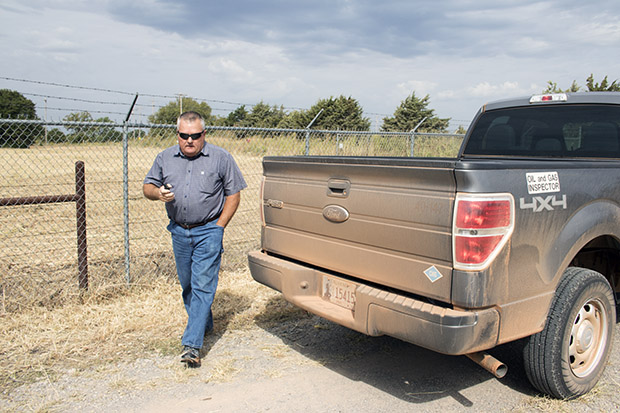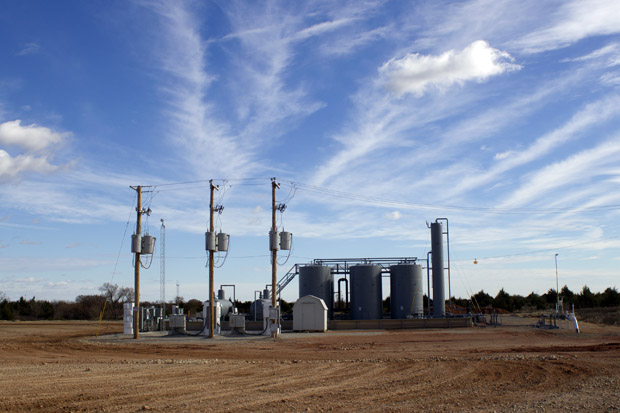
Gary Matli, a field inspector supervisor for the Oklahoma Corporation Commission, checks on a disposal well located east of Guthrie, Okla.
Joe Wertz / StateImpact Oklahoma


Gary Matli, a field inspector supervisor for the Oklahoma Corporation Commission, checks on a disposal well located east of Guthrie, Okla.
Joe Wertz / StateImpact Oklahoma

Joe Wertz / StateImpact Oklahoma
Gary Matli, a field inspector supervisor for the Oklahoma Corporation Commission, checks on a disposal well located east of Guthrie, Okla.
While the research connecting Oklahoma’s earthquake surge to oil and gas activity is built on algorithms, statistical analysis and computer models of fluid flow and seismic energy, monitoring compliance with regulatory actions designed to stop the shaking relies on muddy, manual fieldwork.
In July, after a widely felt 4.5-magnitude earthquake struck near the town of Crescent, oil companies agreed to shut down several disposal wells. The Oklahoma Corporation Commission, the state’s oil and gas regulator, on Aug. 3 imposed strict new limits on the volume of drilling waste fluid companies can pump into about two dozen wells, most of which are in Logan, Payne and Oklahoma counties.
The August volume cuts — which occurred as Gov. Mary Fallin publicly acknowledged for the first time the industry’s role in the shaking — are the state’s most recent effort designed to stop earthquakes linked to the oil and gas industry. The idea, says commission spokesman Matt Skinner, is to reduce volumes to below levels recorded in 2012 — when the shaking started spiking in the area.
“Up until relatively recently, this was the most seismically active area we had in terms of magnitude and number of quakes,” Skinner says, steering his pickup onto a slimy, rutted road east of Guthrie.
The August orders are staggered, requiring disposal well operators to reduce volumes in three phases over three months. After Oct. 2, regulators hope to have cut the amount of waste fluid pumped into the wells by at least 38 percent. After each deadline, field workers inspect each well manually to make sure oil and gas companies are following the regulator’s instructions.
StateImpact tagged along on a round of inspections on Sept. 8.
Gary Matli, a field inspector supervisor for the commission’s district two field office, visited disposal sites, checked clusters of instruments and verified that the proper amount of fluid was being pumped underground.
“You pull into a well and check the gauges,” Matli says. “There usually are three gauges on the well. One on the tubing, one on the casing and one on the surface casing.”
Many of the disposal wells — including most of the wells operated by big-name oil and gas companies — can be checked remotely. We encountered one such well, the Harvey disposal well operated by Devon Energy, during the Sept. 8 inspections. Devon voluntarily shut down the Harvey well in July, Skinner says.
“We can actually do this from the office, but to be perfectly sure and to treat everybody the same way, we put an inspector on site once a week to be sure there’s no sign at all that this disposal well has been used,” he says.

A Devon Energy disposal well near Stillwater, Okla.
Oklahoma experienced a record number of earthquakes in 2014. This year will likely end up even shakier. Summer isn’t even over and there have already been more 3.0-magnitude or greater earthquakes so far in 2015 than there were in all of 2014.
Scientists say deep, high-volume disposal wells are particularly risky. For months, state regulators have been scrutinizing those operations. But Skinner says some of the earthquake-prone areas in Oklahoma don’t have many disposal wells that fit that profile.
“It’s not one size fits all,” Skinner says. “It depends on where you are. This is a very complex state in terms of geology.”
The latest research on Oklahoma’s earthquake surge suggests the cumulative rate and volume of waste fluid from multiple wells could be responsible for many of the earthquakes. Regulators hope slashing disposal activity will reduce the shaking.
It could take a long time for regulators and researchers to know whether volume cuts and other actions in the Oklahoma oil patch are having any effect on the earthquake boom. But there are some encouraging signs. There hasn’t been a 4.0-magnitude or greater quake in the area since the wells were shut down and the volume cuts were mandated.
“Every day that goes by without a serious seismic event in this areas is good news,” Skinner says.